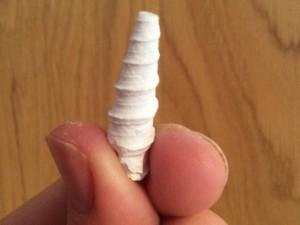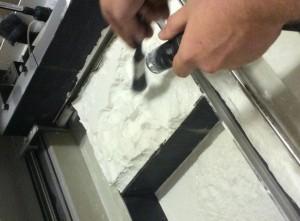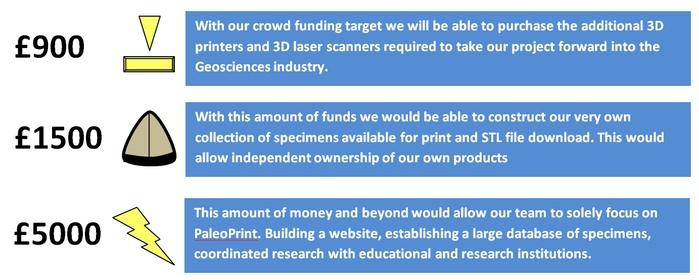 Paleontology, the study of what fossils can tell us about the ecology of the past and about evolution, now incorporates facets of biology, geology, ecology, anthropology, archaeology, and computer science. It’s dedicated to helping us understand the origination — and eventual destruction — of organisms dating back to the beginning of life on Earth.
Paleontology, the study of what fossils can tell us about the ecology of the past and about evolution, now incorporates facets of biology, geology, ecology, anthropology, archaeology, and computer science. It’s dedicated to helping us understand the origination — and eventual destruction — of organisms dating back to the beginning of life on Earth.
 Now Alex Clarke, a recent graduate of the University of Derby in Geology and Environmental Hazards, wants to use his love for paleontology and his family’s involvement in 3D CAD to innovate with 3D print for the geoscience industry.
Now Alex Clarke, a recent graduate of the University of Derby in Geology and Environmental Hazards, wants to use his love for paleontology and his family’s involvement in 3D CAD to innovate with 3D print for the geoscience industry.
“We are a unique service that provides fossil replica models, 3D Printed terrain and rock pore fluid simulation to educational and research institutions,” Clarke notes of his PaleoPrint project.
Clarke says 3D printing fossils will help researchers to “efficiently replicate bones that previously were cast with plaster.” He says his PaleoPrint team will create small scale models of everything from dinosaurs to tiny, detailed fossils too rare and delicate to be handled by students.
To make it happen, funds from a Kickstarter campaign will be used to improve the technology through which his company will produce the printed fossils, with a £900 goal to reach before the campaign ends on March 17th.
At this point, PaleoPrint is a 3D printing service within the paleontological industry which provides fossil replica models to the education and research industries through 3D printing.
“One of our first samples was a 200 Million year old fossil, production cost of this specimen was only £2.30, making it cheap for replication,” Clarke says. “Using our Stratasys 3D printer, we can achieve millimetric precision needed for the replication of fossils, using over 30 years of CAD experience we have perfected the process in which it takes to produce spotless prints. We have used a variety of scanners over the last year from which we have identified the most suitable 3D scanner that will take us forward.”
 The PaleoPrint team has been focused on developing the smaller, more detailed fossils which, while not particularly rare or hard, provide the precision and detail to demonstrate the capabilities of their printer.
The PaleoPrint team has been focused on developing the smaller, more detailed fossils which, while not particularly rare or hard, provide the precision and detail to demonstrate the capabilities of their printer.
3D printing offers numerous advantages over the standard method in use now — plaster casting fossils. Clarke says the 3D printed versions feature superior detail and accuracy, that 3D scanning vastly reduces the handling of specimen fossils and that 3D files can be sent from an excavation site through portable scanning.
Over the long haul, Clarke says the idea is also to create a database of 3D scanned fossils which could be download by the public or purchased as replicas through PaleoPrint.
The company now uses a ZPrinter 310 Plus 3D printer.
The project also hopes to examine fluid mechanics in rock pores by 3D scanning geological surfaces to study the movement of fluids such as oil and gas through the lithology of those structures.
Clarke says that work might potentially be used to fine-tune methods in fracking and other oil and gas extraction techniques. Funds from a successful Kickstarter campaign will be used to expand PaleoPrint’s services to international markets. The campaign includes stretch goals beyond the £900 goal mark, as illustrated below.
Do you know of any applications of 3D printing in a historical context? Will you back this Kickstarter campaign? Let us know in the PaleoPrint 3D Fossil Printing forum thread on 3DPB.com.
Subscribe to Our Email Newsletter
Stay up-to-date on all the latest news from the 3D printing industry and receive information and offers from third party vendors.
You May Also Like
Precision at the Microscale: UK Researchers Advance Medical Devices with BMF’s 3D Printing Tech
University of Nottingham researchers are using Boston Micro Fabrication‘s (BMF) 3D printing technology to develop medical devices that improve compatibility with human tissue. Funded by a UK grant, this project...
3D Printing Webinar and Event Roundup: April 21, 2024
It’s another busy week of webinars and events, starting with Hannover Messe in Germany and continuing with Metalcasting Congress, Chinaplas, TechBlick’s Innovation Festival, and more. Stratasys continues its advanced training...
3D Printing Webinar and Event Roundup: March 17, 2024
It’s another busy week of webinars and events, including SALMED 2024 and AM Forum in Berlin. Stratasys continues its in-person training and is offering two webinars, ASTM is holding a...
3D Printed Micro Antenna is 15% Smaller and 6X Lighter
Horizon Microtechnologies has achieved success in creating a high-frequency D-Band horn antenna through micro 3D printing. However, this achievement did not rely solely on 3D printing; it involved a combination...






























